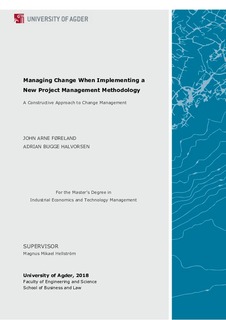| dc.description.abstract | Standardisation of project management seems to become more significant for several actors in the
construction industry. Current models for project execution do not make enough effort to utilise
expertise and experience to make the product better and the price lower, and grant few incentives
to use new technology (Statens Vegvesen, 2017).
An initiative by employees in Sweco Norway has resulted in the creation of a new project
management methodology, which they believe will enable them to execute their projects in a more
structured and standardised manner. The new methodology is a toolbox consisting of ten tools,
amassed from best practices for project management at Sweco’s various locations in Scandinavia.
As no standardised way of executing projects have ever existed at Sweco, project leaders have
approached project management based on individual preferences, resulting in various approaches.
Our thesis seeks to answer how the new project management methodology can successfully be
implemented, as change efforts often fail. Thus, our research question is:
How could Sweco’s new project management methodology be implemented?
The Constructive is chosen for the methodological framework for our thesis.
It is a research approach that seeks to develop or that will solve a practical
problem (Lukka, 2003). Our construct to solve Sweco’s practical problem will be a model,
consisting of phases and recommendations tailored for Sweco’s specific implementation. Data is
gathered from semi-structured interviews in two of Sweco’s locations, Oslo and Bergen. Two main
groups where interviewed: initiators and future users of the new methodology. To form a construct
and answer the central research question, the following sub-questions have been formed:
- Why is change needed?
- What could inhibit the change?
- How should Sweco strategise for this change?
The first sub-question is answered through an analysis of the interviews. We have addressed the
most reoccurring needs and themes throughout the interviews, both for initiators and users. The
interviewees were questioned about their own and Sweco’s needs for improvements to their project
management. It became evident that they believe, or hope, that this change will earn them benefits
in several areas linked to standardisation, processes, customers, cooperation, results, progress and
iii
avoiding risk. This change is said to hopefully enable everyone to “speak the same language” and
allow the customer better transparency throughout the project lifetime.
For the second sub-question, the interviewees were asked questions about opposition to the change
initiative. Our questions were based on a theoretical framework for resistance, which enabled us
to categorise the kinds of resistance and later pick a suitable approach to deal with the resistance.
The most significant concern of what could inhibit the change initiative was found to be resource
allocation. Several wondered how they will be able to adapt to the new methodology in their already
demanding schedules.
The third sub-question, how to strategise for the change, is answered with a framework for
analysing change. In this framework, four factors are evaluated: kind and amount of resistance, the
relationship of power between resisters and initiators, knowledge about what changes are needed,
and the stakes involved. The evaluation of these factors suggests in our analysis a slow approach
to the change. It will require involvement and participation of others and will attempt to educate
the employees in the ways they need. Half of the interviewed users also said they would be more
likely to use the methodology if they are required to.
The sub-questions, along with a synthesis of theoretical models for change management, has
enabled us to create a construct for Sweco as guidance in their implementation process. The
construct, seen below, consists of seven phases that we encourage Sweco to utilise. | nb_NO |

